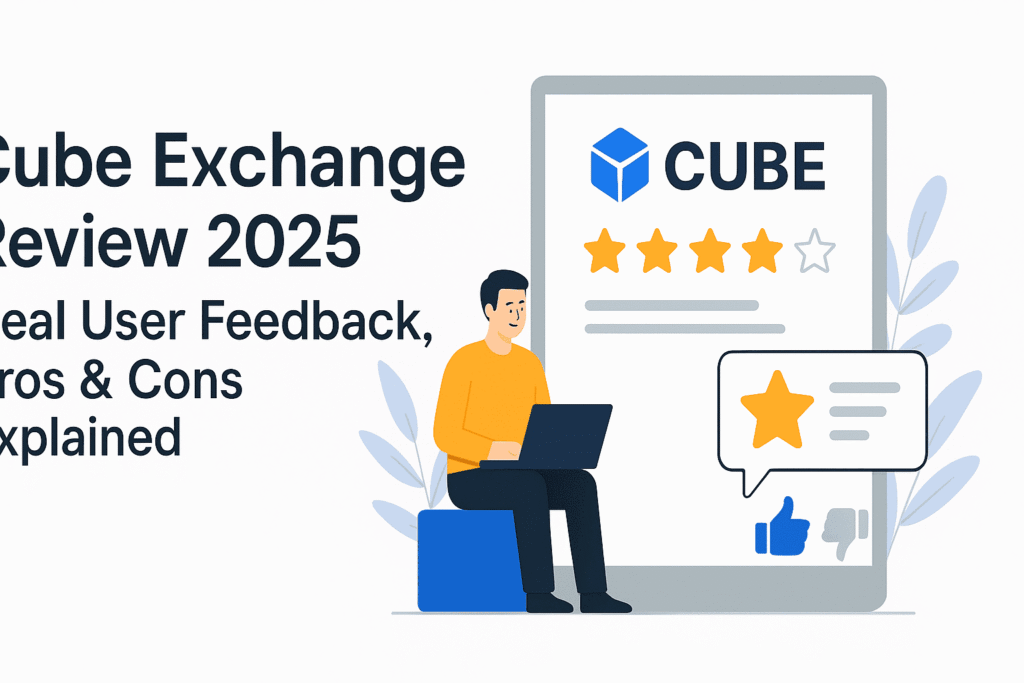Cube Exchange Review 2025: Real User Feedback, Pros & Cons Explained

🔍 Introduction – Cube Exchange Review
Ever feel like crypto exchanges either make you choose between security and speed, or self-custody and convenience? Cube Exchange is changing that game. In 2025, it’s one of the most talked-about platforms, blending centralized exchange performance with decentralized safety. So, is the hype justified? Let’s break it all down in this human-written, no-nonsense review—based on real feedback and in-depth analysis.
💡 What is Cube Exchange?

Brief Background and History
Cube Exchange launched to solve a growing problem: how do you keep the speed and liquidity of centralized exchanges while staying true to crypto’s decentralized roots? Founded by industry veterans, Cube emerged with a unique vision—what if you didn’t have to choose?
Who Founded Cube Exchange?
Cube is the brainchild of Bartosz Lipiński, an ex-FTX executive who knows both the pitfalls and possibilities of centralized platforms. His mission? Build a better exchange that users can actually trust.
What Makes It Different in 2025?
It’s 2025, and Cube isn’t just another crypto exchange. It’s a hybrid model offering fast execution, institutional-level tools, and non-custodial user control—all wrapped into one sleek platform.
Official Website – Cube Exchange
⚙️ How Cube Exchange Works

Trading Interface & User Experience
Cube’s UI is clean, fast, and responsive. Real-time charts, one-click orders, and a well-designed mobile app make it beginner-friendly yet powerful enough for serious traders.
Supported Assets & Markets
As of mid-2025, Cube supports major cryptos like BTC, ETH, SOL, AVAX, and emerging tokens. Perpetuals and spot markets are both available with deep liquidity.
Cube’s Cross-Margining System Explained
This unique feature lets you trade across assets using shared collateral, minimizing liquidation risk and maximizing efficiency—a huge plus for active traders.
🌟 Key Features of Cube Exchange

Hybrid Order Book (CEX + DEX Blend)
Cube uses a centralized order book for speed, paired with decentralized settlement to ensure custody remains with the user. Think of it as the best of both worlds.
Self-Custody Model
Assets are never held by Cube. Instead, they remain in multi-party computation (MPC) wallets you control, even during trading. That’s rare and revolutionary.
Lightning-Fast Settlements
Orders execute in milliseconds thanks to a robust matching engine. Settlement happens without compromising decentralization—a technical feat that impresses even devs.
Security Architecture & MPC Wallets
Your assets are protected by cutting-edge MPC tech—meaning even Cube can’t access your funds. It’s security on par with institutional-grade solutions.
👉 Blip Finance Review (2025) | Is This Crypto Trading App Worth It?
🔍 Cube Exchange vs Binance, Kraken, and Coinbase (2025)
| Feature | Cube | Binance | Kraken | Coinbase |
|---|---|---|---|---|
| Custody | ✅ Self-custody | ❌ Custodial | ❌ Custodial | ❌ Custodial |
| Speed | ⚡ Very Fast | ⚡ Very Fast | 🚀 Fast | 🚶 Moderate |
| Security | 🔒 MPC Wallets | 🔒 SAFU + 2FA | 🔒 Strong | 🔒 FDIC (USD) |
| Fees (avg) | 🟢 ~0.05% | 🟡 ~0.10% | 🟡 ~0.16% | 🔴 ~0.50% |
| Mobile App | ✅ Pro-Grade | ✅ Advanced | ✅ Good | ✅ Beginner Friendly |
| Fiat Support | ❌ Not Yet | ✅ Yes | ✅ Yes | ✅ Yes |
🆕 Cube Exchange 2025 – What’s New This Year?
Updated UI and Mobile App Improvements
Cube rolled out a sleek redesign in Q1 2025. The mobile experience now rivals desktop in terms of functionality and speed.
New Listings and Assets Added
Cube is aggressively listing newer tokens like SUI, PYTH, and JUP while maintaining top-tier liquidity.
Institutional Trading Tools
Features like APIs, FIX protocol support, and advanced risk dashboards now cater to pro traders and funds.
🗣️ Real User Feedback (2025)
What Users Love About Cube Exchange
- Blazing-fast execution
- Complete control over funds
- No FTX-style fears
- Institutional-grade tools for retail users
Common Complaints and Criticism
- Still lacking some altcoin variety
- Occasional bugs in the mobile app
- Not yet fully integrated with all hardware wallets
Cube Exchange vs Competitors
Compared to Binance, Kraken, and Coinbase, Cube stands out for its self-custody-first model. While others focus on volume, Cube builds for trust.
✅ Pros and Cons of Cube Exchange
Major Advantages
- Self-custody trading
- Fast and seamless order execution
- Transparent operations
- Ideal for both retail and institutional users
Key Limitations to Be Aware Of
- Fewer listings than Binance
- Still a newer platform
- Limited fiat on-ramp options (for now)
🎯 Cube Exchange for Beginners vs Advanced Traders
User-Friendliness for First-Timers
A guided onboarding and clean UI make Cube beginner-ready. Plus, you don’t need to understand private keys to stay in control.
Pro Tools for Power Users
Want API access, custom order types, or detailed analytics? Cube’s got all that—and more.
🔐 Security & Trustworthiness
Custody, Compliance, and Transparency
Cube is transparent about its operations and doesn’t play with user funds. No backdoors, no hidden risks.
Regulatory Status and KYC
Fully KYC-compliant for legal jurisdictions. U.S. access is currently limited, but global traders are welcome.
💰 Cube Exchange Fees in 2025
Trading Fees Overview
Cube’s trading fees are competitive—often 0.05% or lower, with volume-based discounts for high rollers.
Deposit & Withdrawal Charges
Zero deposit fees for crypto. Withdrawals are standard network fees only. No hidden surprises.
🚀 How to Get Started with Cube Exchange
Creating an Account
Just an email and password to sign up. KYC required for full features.
Making Your First Trade
Deposit, choose a pair, and execute—it’s that fast. UI guides you every step.
Funding and Withdrawing
Support for major wallets. Withdrawals are quick, and you stay in control.
📞 Customer Support and Community
Support Channels
Live chat, email, and a help center. Response times are solid, usually under 24 hours.
Community Engagement (Twitter, Discord, etc.)
Cube’s community is active, especially on X (formerly Twitter), Discord, and Telegram. AMA sessions happen monthly.
🛣️ Cube Exchange Roadmap and Future Plans
Expansion Goals
Plans to enter the U.S. market, improve fiat integrations, and add DeFi access via L2s.
Upcoming Features and Releases
Cube is working on integrating staking, social trading, and more institutional-grade features in 2025 and beyond.
🏁 Final Verdict – Is Cube Exchange Worth It in 2025?
Yes—especially if you care about both speed and security. Cube is one of the few platforms that balances decentralization with top-tier performance. It may not have every token or fiat option yet, but for crypto-native users who want control, Cube is a no-brainer.
🧾 Conclusion
Cube Exchange in 2025 isn’t just another platform—it’s a reimagination of how trading should be. It brings together speed, safety, and sovereignty in a sleek package. Whether you’re new to crypto or a seasoned pro, Cube is worth checking out.
❓ FAQs
1. Is Cube Exchange safe to use in 2025?
Yes, it uses MPC wallets and self-custody principles. Your funds never leave your control.
2. Can U.S. residents use Cube Exchange?
Currently, access is limited. However, global users can register and trade freely.
3. What coins can I trade on Cube Exchange?
You can trade BTC, ETH, SOL, AVAX, and several other blue-chip and new tokens.
4. How does Cube Exchange compare to Binance or Coinbase?
It offers better self-custody and security, though with fewer tokens and no fiat on-ramp (yet).
5. Does Cube Exchange have a mobile app?
Yes, and the 2025 version is smooth, fast, and includes full trading features.
Please don’t forget to leave a review.

One Comment